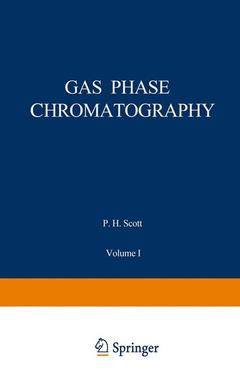Description
Gas Phase Chromatography, 1960
Volume I: Gas Chromatography
Author: Kaiser Rudolf
Language: English
Subject for Gas Phase Chromatography:
Keywords
Sorption; adsorption; chemistry; chromatography; experiment; influence; nomenclature; phase; physical chemistry
Approximative price 52.74 €
In Print (Delivery period: 15 days).
Add to cart
Publication date: 04-2012
199 p. · 14x21.6 cm · Paperback
199 p. · 14x21.6 cm · Paperback
Description
/li>Contents
/li>
THE present volume, which is the first of a three-volume work on gas phase chromatography, deals with the problems of gas chromatography in packed columns. Gas chromatography, like any other analytical method, is mainly a matter of practical skill, and therefore emphasis has been given to the apparatus at the expense of a more detailed presentation of the theory. The aim of this book is to make lecturers and students, chemists, works engineers and laboratory workers familiar with this highly effective branch of analytical physical chemistry. I hope too that the experienced worker may find references which will be of value to him in his work and which will spare him part of the now almost impossible task of keeping up to date with the literature. The nomenclature used here is the result of a number of discussions with Professor E. Cremer and Dr. E. Bayer, and I should like to take this opportunity of expressing my grateful thanks to them. The present book is based partly on my book Gas Chromatography which appeared at the end of 1959. Numerous discussions with Professor E. Leibnitz and his colleagues H. P. Angele, M. Hofmann, H. Holzhauser, M. Kuhl and H. G. Struppe and the experimental work carried out with them have all influenced this revision. I should also like to thank Dr. H. Kienitz and his colleagues Dr. K. Dorfner, Dr. H. D. Ermshaus and Dr. H. Runge for valuable suggestions.
Survey of the four fundamental chromatographic methods—Limits of application, definitions and methods of gas chromatography—Nomenclature—History of gas chromatography.- 1. Theory of Gas Chromatography.- Definition and derivation of the characteristic values for gas chromatography—Retention volume and partition coefficient—Retention values and the liquid phase in isothermal gas chromatography—Height equivalent to a theoretical plate—Separation formula for gas chromatographic methods—Selectivity, column performance and resolution—Retention values and temperature of separation; retention temperature—Number of theoretical plates and peak form—Gas chromathermography by the circulation technique.- 2. Apparatus.- 2.1. The column.- The column packing—Evaluation of packed columns—Calculation of the number of theoretical plates, column performance and separation factor—Resolution—Calculation of the number of theoretical plates or column length necessary for a given separation—Load capacity—Performance index—Time of analysis and resolution—Column material—Column diameter—The solid support—Removal of residual adsorption activity—Particle diameter—The liquid phase—Quantity of liquid phase—Impregnation of the support—Testing the column packing—Peak form—Control of the quantity of liquid phase —Temperature load capacity—Filling the column—Testing the column—Ageing of the column packing—Summary of the factors governing the preparation and operation of efficient columns.- 2.2. The carrier gas.- Gas purification—Control and measurement of the carrier gas flow rate—Disturbances of constant flow rate—Production of a constant gas flow rate—Gas tightness—Flow rate meters.- 2.3. The sample injector.- Sample injectors for gases—Sample injectors for liquids.- 2.4. Detectors.- Desirable and necessary properties of detectors—Principles of measurement—The thermal conductivity cell—The flame ionization detector—Testing of detectors—Comparison of sensitivity.- 2.5. Recorders.- 2.6. Temperature.- The optimum operating temperature—Constant temperature—Temperature control—Heat insulation—Variable temperatures.- 2.7. Industrial gas chromatographs and other special apparatus.- High temperature instruments—Multi-column instruments—Apparatus for preparative work—Sample collection systems— Fully automatic instruments—Trace analysis instruments—Low pressure instruments.- 3. The Analytical Result.- 3.1. The qualitative analytical result.- Preparation of the sample—Choice of the most suitable column and operating conditions—Qualitative evaluation—Qualitative testing of columns.- 3.2. The quantitative result.- Requirements for the quantitative evaluation of gas chromatographic results—Measurement of peak area—Evaluation from peak area measurements—Direct surface area method—Evaluation by peak area measurements using specific calibration factors—Evaluation of the analysis by a calibration method—External calibration of the peak heights—External calibration of the peak areas—Internal calibration with addition of extraneous substance—Internal calibration with component already present—Evaluation by the height and area methods for constant sample quantity—Evaluation methods using integral detectors.- 3.3. Application of gas chromatography to the determination of thermodynamic values.
© 2024 LAVOISIER S.A.S.




